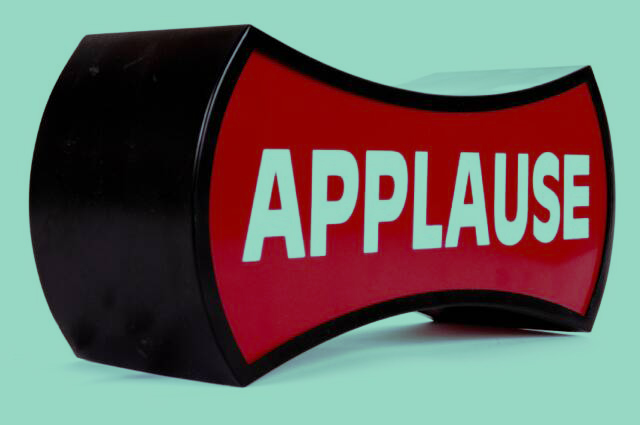Rhetorical Design in Speech Making
Welcome to ‘science time’ with Ozean Media (Yes, it normally it is Science Friday, but I have recently become aware of NPR’s Science Friday so we must re-brand!)
While we re-brand, I came across some literature that I found interesting. We are embarking on a messaging discovery phase for a client, and I began to wonder what studies are out there on structure of messaging and the reception of those messages .
Basically, does rhetoric influence reception of the message?
This question lead me to Max Atkinson‘s research on the 7 rhetorical devices and the applause they generate. This lead me to a paper by John Heritage and David Greatbatch from the University of Warwick who used Atkinson’s research. This paper reviews Atkinson’s research and applies it to political speeches made in Britain.
It is an interesting read, and you can download the entire paper at the end of this post; however, in summary:
- 70% of the applause produced is associated with 7 rhetorical constructions.
- The relationship between the rhetoric and response is independent of party, status of speaker, and the popularity of the message.
- Performance Factors (the speaker’s actions) are found to influence the likelihood of generating a response strongly.
What the findings are showing is that audience responses to political speeches are influenced by the verbal structuring of the statements that are being made. Statements that use 1 of the 7 rhetorical devices were “between two and eight times as likely to be applauded as those who did not.”
In fact, the verbal structure had more to do with the applause and response generated than did the actual argument.
The 7 Rhetorical Devices to generate applause
1. Contrast – This is the Daddy Mack of devices, the mother sauce if you will. If you take away nothing else from this post, remember CONTRAST / ANTITHESIS. It has been used since the Greeks for a darn good reason: it works. Contrast works so well because the core assertion is said twice – in the negative and the positive – and the audience knows exactly when to react.
2. List, in three parts – This is the Daddy Mack, Jr. of devices. In the use of item1, item2, and item3, the “AND” signals to the audience the conclusion of the point and primes them for applause.
3. Puzzle-Solution – The speaker establishes a puzzle, and then provides the answer with the answer being the core message.
4. Headline-Punchline – Similar to Puzzle Solution, but more simple and less potential for elaboration (think soundbite).
5. Combination – combining all the devices above, with most combinations using contrast together with another device.
6. Position Taking – describes a state of affairs that the speaker is expected to take a strong stance with the description containing little to no overt evaluation. At the end, the speaker unequivocally praises or condemns the state of affairs.
7. Pursuit – When all fails, if an audience fails to respond, speakers may actively pursue applause by simply priming the message and then restating.
The Results of the Study of Rhetoric
As you can clearly see, contrast by far is the greatest deliver of applause – the mother sauce.
In summary, the study states about the table above:
Taken as a whole, table 5 provides impressive general support for the hypothesis that political messages that are packaged in rhetorical formats embodying emphasis and projectability are more likely to be applauded than messages that are not so packaged. The distribution of applause in association with the various formats described is generally stable regardless of political party and type of speaker. This conclusion is qualified only by a slight tendency for more practiced political speakers to gain a higher proportion of their applause from rhetorical devices than run-of-the-mill conference participants. These results suggest that there is a fundamental tendency for audiences to respond to political statements that employ the rhetorical devices and that experienced political speakers use them more often, or more appositely, or deliver them more effectively.
Additional Finding
As you may guess, the politician’s skill at delivering the speech greatly affects the outcome.
Something as simple as eye contact was greatly noticed. When a line failed to generate applause, the researchers were “struck by the repeated failure of many speaker to sustain eye contact with the audience when making significant points.”
Tucked into the study is the following conclusion: “while they (the audience) may have been able to recognize that a significant point was being made, were generally reluctant to respond to it in the absence of any additional signal from the speaker that the point was of real importance.”
Speakers can do this by the stress they place on their points, and speakers generate this defined stress in 5 main ways:
- gazing at the audience at or near the completion point of the message
- delivering the point more loudly than the surrounding speech passages
- delivering the point with great pitch or stress variation
- delivering the point with marked speeding up, slowing down, or some other rhythmic variation
- delivering the point accompanied by the use of gestures
Conclusion
While every politician or aspiring politician may not be able to hire a full time speechwriter, there is no excuse NOT to learn the basics.

It is clear, The mere way one structures & delivers an argument has a huge impact on the effectiveness of an argument.
Any politician would improve their stature not with long, boring litanies of facts, but rather with an understanding of how to construct an argument using these 7 rhetorical devices. Then one must practice, practice, practice delivering them.
OR
As my Mamma said, “Son, it is not what you say, but how you say it!”
Read the entire study: Generating Applause: A Study of Rhetoric and Response at Party Political Conferences


